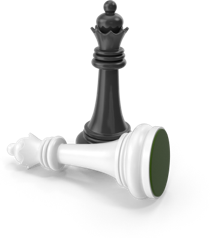Which crypto investing strategy is for you?

From buying and holding long-term to day trading to searching for undiscovered crypto gems, there’s no shortage of ways you can make money in crypto. If you’ve decided you want to make the most of cryptocurrency, the first step is deciding what kind of investor you want to be.
Want to invest and then sit back and wait while your gains pile up, or would you prefer a more active approach that could lead to some serious profits within the week?
This article will give you an overview of the 3 main investing strategies in crypto so you can decide which one is right for you.
Key Takeaways
- No two investing strategies are the same. Your approach will depend on your circumstances, risk tolerance and financial goals
- Buying & holding for the long term is a common strategy that suits many casual/serious investors
- You don’t have to choose a single investing style. Incorporating a blend of all 3 can give you the stability you want, plus a bit of excitement in the short term
- Dollar-cost averaging (DCA) is a tried-and-tested strategy that can help you time your entry into the market
- Day/Swing trading can be highly profitable but comes with a higher degree of risk and involvement than simply investing for the long term
Here are the 3 main investing strategies in crypto:
Buy & Hold – Long term
‘Buy and hold’ is a highly popular investment strategy that suits many people. It is the most passive style of investing, where you choose a few promising cryptocurrencies to invest in. This is often done through Dollar-cost-averaging (DCA), which is basically buying small amounts of crypto incrementally (more on this in the FAQ below).
This type of investing is low-stress and suits people who believe in the long term potential of crypto and are willing to hold out for a long time, regardless of short term fluctuations in the markets. Holding or ‘HODLing’ is a great strategy for beginners and veteran traders alike.
The buy & hold strategy suits those who:
- Are new to crypto but want to gradually get involved before it’s too late
- Want a relatively low-stress, hands-off approach to investing
- Only want to check how their crypto portfolio is doing once in a while
- Believe in the long term potential of crypto & prefer a more passive approach
- Do not want to keep up with every piece of crypto news
- Do not need to see any returns for a few years, if not more
- Are okay with enduring times of volatility and slumping prices
- Are interested in projects with strong fundamentals who will be around in 5-10 years
Buy & hold example:
Daisy has done some research and has decided that crypto will be an important part of the future.She sees the potential in coins like Bitcoin, Ethereum and some other established projects, and she believes in the power of decentralised finance beyond banks.
Daisy wants to get involved in crypto while the market is still in its early days, so she chooses 4 well known coins in Bitcoin, Ethereum, Cardano and Chainlink. Given that she is planning to invest over a long period of time, Daisy uses the Dollar-cost-averaging method so she doesn’t have to worry about timing her entry into the market.
She signs up to a reputable and user-friendly exchange like Digital Surge and sets recurring buys of small amounts of these 4 cryptocurrencies to occur every week. Over time, and without having to check the market (unless she’s curious), Daisy builds up a solid portfolio which she intends to hold for the long term, hoping that a few years down the track her investments will have made her a tidy profit. Simple, easy and potentially highly profitable.
Note: The buy and hold strategy is usually based on fundamental analysis and doesn’t concern itself with the technical indicators that day traders use. If you’re new to crypto, this is a strategy we would recommend, but keep in mind, you can start with this approach and then add in bits of other trading styles as you learn more about crypto. For a simple but comprehensive guide on how to evaluate a good crypto investment, click here.

Swing trading – Short-Medium term
Swing trading involves trying to take advantage of price moves that happen on a short to medium time frame (usually a few days to several weeks).
Swing trading strategies work best when there’s a strong trend on a long time frame (like during a massive bull run). During these periods, there is a lot of volatility and large price swings even though the overall trend is up, providing swing traders with ample opportunity to predict trends and turn a profit in a short amount of time.
Swing trading is for someone who:
- Notices a bull market or a particularly volatile period and wants to make the most of it
- Has some understanding of the market and can spot short-medium term trends
- Is interested in investing in solid long term projects but is also willing to buy/sell for short term profit
- Who has a decent tolerance for risk and can handle market volatility and their portfolio seeing some average days
Swing traders will assess the same fundamentals of a project as long term traders, while also employing some degree of technical analysis (Support/resistance levels, trendlines, etc.) to generate trade ideas (though not to the same extent as day traders would do).
Swing trading example:
Paul notices that a well established cryptocurrency called Cardano has been trending up over the past few months. Cardano’s tech is solid and the team is world-class, and he has just learnt that Cardano has a bunch of major announcements & updates happening in the coming weeks. The next time Paul sees Cardano dip 5% below its current price, he buys a big stack and then sits back and waits.
As time goes on, Cardano’s announcements are made, and they turn out to be significant. More investors pile in to get a piece of Cardano and the price increases by 25% over a few weeks.
At some point Paul sees that the price has levelled out and is moving sideways for a few days, so he sells most of his Cardano stack (keeping about 25% of it in case the price does go up again), takes a tidy profit and starts looking for the next project that is likely to see a large price swing in the short-mid term. Paul bought the dip and sold at a peak. That’s swing trading.
Day trading – Short term
The most high-stress-high-risk-high-reward strategy of all. Day trading involves sitting at your computer and watching the market like a hawk in order to take advantage of any market movement you can.
This style of trading usually involves multiple trades within a day (lots of small profits can add up), but having a solid understanding of technical analysis is necessary to be successful at this type of trading in the long run.
Day trading is for someone who:
- Has a deep understanding of technical analysis & the crypto market
- Has a high risk tolerance and plenty of time to dedicate
- Is willing to put themselves in high stress situations to make short term profits
- Cares more about profit than they do about supporting the industry & investing in projects with solid fundamentals and long term potential
This style of trading is time intensive and NOT suited for beginners. However, many people do end up day trading due to the potential for short term profits that exists in such a volatile market. If you are serious about day trading, knowledge and practice is key.
Most people who jump in with little understanding, and try to make the most of short term volatility, end up getting burnt, so this strategy is not recommended for beginners. Check out this simple guide on how to avoid the top beginner crypto mistakes!
Day trading example:
John is a day trader who has just heard about a cryptocurrency called WaxCoin that is set to be listed on Coinbase later that day. After doing some very quick research of WaxCoin he determines that it is a highly speculative investment that is making some big promises to revolutionise the borrowing/lending sector of crypto. WaxCoin doesn’t have the fundamentals and partnerships of other coins in the sector but they have a legit looking website and a few reputable developers on the team.
John knows that after the coin is listed on Coinbase it will likely see a huge spike in value as Coinbase users pile in to get a hold of the newly listed coin. However, he also knows that this spike is bound to come down just a few hours after the listing. With this knowledge (and with no intention of holding WaxCoin long term) John buys a bag of WaxCoin and sets an automatic sell order for when the price doubles its current value.
Hours later John is at his computer as WaxCoin gets listed, and as he predicted his coin shoots up in value, however, after a few hours the coin has only seen a 25% increase in value and looks to be levelling out. Despite not reaching his goal of 100% profit, he places a new sell order and takes the profit he has made.
Later that evening, John is at his computer watching the charts like a hawk. He sees WaxCoin start to show a strong downwards trend backed by various technical indicators so he ‘shorts’ the coin (betting on it dropping instead of increasing), making a little extra cash of the short-term downfall of WaxCoin. That’s day trading. On a good day. John has plenty of other days that have left him in tears, wondering what he is doing with his life.

Crypto Investing strategies FAQ
How does Dollar-cost-averaging (DCA) work?
Dollar-cost averaging (DCA) is a tried-and-tested strategy that is perfect for beginners or anyone who doesn’t have the time to constantly watch the markets for the best entry point.
Basically, DCA is investing a total sum of money in small increments over time, instead of all at once. The aim is to flatten out the market’s volatility – to take advantage of market downturns without risking too much capital at any one time.
Benefits of DCA
- Reduces the risk of buying at market tops
- Offsets the negative effects caused by short-term market volatility
- Doesn’t require big upfront investment
- Set and forget – just automate & sit back while your portfolio is built
Over the long term, investing bit by bit is usually a better plan than constantly trying to guess the best time to enter the market, which is very hit and miss unless you really know what you are doing.
DCA is a very useful tool which you can automate using Digital Surge’s recurring buys feature. This allows you to invest consistently with as little risk as possible. Forget about bad timing and just enter in when you want to buy, how much and how often, then sit back and relax while Digital Surge’s easy-to-use app builds your portfolio for you.
Here’s an example:
Rather than buying your portfolio all at once, you instead buy parts of it at intervals. Every week you might want to purchase 50 dollars of Bitcoin and 30 dollars of Ethereum, while playing around at buying some other altcoins you like when they are at reasonable prices.
While this will take longer to assemble your total portfolio, it is a strategy we recommend. You might decide to buy 10% of your portfolio every month, or 5% every week if you are in a rush to get your portfolio assembled.
Note: Digital Surge allows you to trade with as little as $10 per trade – so if you’re looking at entering the market gradually, we’ve got you covered!
What is buying the dip?
‘Buying the dip’ refers to getting a coin when the market is in a dip and prices are lower than usual. While it can be nerve racking to invest in a coin that’s dropping in value, if you have faith in the tech and long term potential of the project, this is an extremely lucrative strategy.
For coins such as Bitcoin and Ethereum, which are relatively stable and safe long term bets, you can build a tidy stack of both by capitalising when the market is in a temporary downtrend. This is a strategy ALL crypto investors should know about and is undoubtedly one of the best ways to turn a profit in the crypto markets.
Some of the biggest gains in all of crypto come from taking profits when things are good, and then buying back during a bear run or major dip when the market has crashed and people are too scared to invest. Be fearful when others are greedy, and greedy when others are fearful.
How do you use a blend of trading strategies?
When it comes to investing strategies, some people want the best of both worlds. A common situation is a buy and hold investor also wanting to play around a little to see if they can make some short term profits during a bull run.
Using a blend of long term/short term investing strategies can looks like this: You might have 80 percent of your portfolio allocated to established coins like Bitcoin, Ethereum and Polkadot and now want to use the remaining cash to gamble on a few low or mid caps that are being hyped to pump very soon. Check out our article on how to diversify a crypto portfolio to get started on the right foot!
While it is advisable to leave most of your crypto portfolio alone if you are in it for the long term, another example would be taking a 5-10% profit the next time Ethereum or Bitcoin spikes, and then using that money to try your hand at swing/day trading.
You’ll have the stability that you wanted, plus the potential for short term gains. That’s just one way you can blend a few strategies together. It’s also a great way to learn about different approaches (in a relatively low risk way), so you can know what type of trader/investor you want to be in the future.
What is the difference between swing trading and day trading?
Day traders aim to capitalise on very short term price moves, while swing traders look for moves that occur over a number of days, weeks and sometimes months. Day trading is a more active and stressful strategy, requiring near constant monitoring of the market to open and close positions within the day.
Swing traders can take a more passive approach (but still nowhere near as passive as buying and holding). They are looking at longer time frames, which means they can check the market less frequently and can often bring in sizable returns from just a few trades over a period of months.
Day traders almost exclusively use technical analysis, while swing traders will typically use a combination of technical analysis and fundamental analysis. However, both require some knowledge of technical analysis, chart interpretation and how the crypto markets work.
How do you become a successful day trader?
You basically have to dedicate a whole bunch of time to learning and understanding the crypto markets, plus all the bells and whistles of technical analysis. While the returns (especially during bull runs and times of volatility) can be significant, this approach is not for the faint of heart.
You will have to learn about things like candlesticks, bar charts, moving averages, trend lines and support and resistance levels if you are to win at day trading over the long term. If you are interested, there are plenty of guides and courses online that will help you learn the ropes of this high-risk-high-reward strategy.

What is margin/leverage/futures trading?
This type of trading is NOT for beginners and carries a great deal of risk. Margin trading is an advanced method of trading assets using borrowed funds provided by an exchange or third party.
When compared to regular trading, margin trading allows you to access greater sums of capital so you can leverage your trades and amplify the profits you make from successful trades. But the same goes for losing trades. It is a high-risk-high-reward kind of trading that day/swing traders often use if they are extremely confident. But beware, many people get into trouble trading this way, so unless you’re a market wizard we don’t recommend this kind of trading.
What’s the difference between trading & investing?
While the terms trading and investing are often used interchangeably, there is a distinction that all beginner traders should understand.
If you are looking to invest, it usually refers to a longer-term strategy and you should not expect to see quick returns on your investments. This is usually a low-risk strategy that involves choosing a few coins that you think will perform well over a number of years.
On the other hand, a trader speculates on the market and price movements over a short period of time. This is a more involved approach which requires a stronger stomach, risk tolerance and the ability to stay composed in high-pressure situations.
It is generally recommended that you should have a well-diversified portfolio with a blend of small, mid and large-cap investments (with the majority of your portfolio being more stable, established coins). That way, you minimise your overall risk while still having the possibility of big gains in the short-term.
If you’re not sure about whether this new technology is for you, check out our guide on if investing in cryptocurrency is for you.
Final Words
We hope this article has taken you one step closer to finding the right investing strategy for you. As always, these are just guidelines, and the best approach will probably take some time to work out.
If you’re ready to get started and are looking for the easiest way to buy cryptocurrency in Australia, check out Digital Surge – an exchange that makes buying, selling and storing over 260+ cryptos simpler and easier-to-understand than ever before.
With an incredibly user-friendly interface, extremely low fees & a customer-support team you can rely on, getting involved in crypto has never been easier. Sign up today and enjoy safe, stress-free trading.
At Digital Surge, we believe crypto is the finance of the future. Which is why we’ve created Crypto Simple, a Crypto Education Hub that demystifies cryptocurrency, giving everyday people like yourself the knowledge they need to make the most of this exciting new resource.
See you around!
Did this answer your question?
Digital Surge is the easiest way for Australians to buy, sell & store over 250+ cryptocurrencies. With extremely low fees, a uniquely user-friendly interface and a customer-support team you can rely on, getting involved in crypto has never been easier. Sign up today and enjoy safe, stress-free trading.
Crypto-curious? The time you spend here will be the best investment you ever make.
Enjoy effortless trading today
- ACN 620 473 109
- © 2021 Copyright Digital Surge




